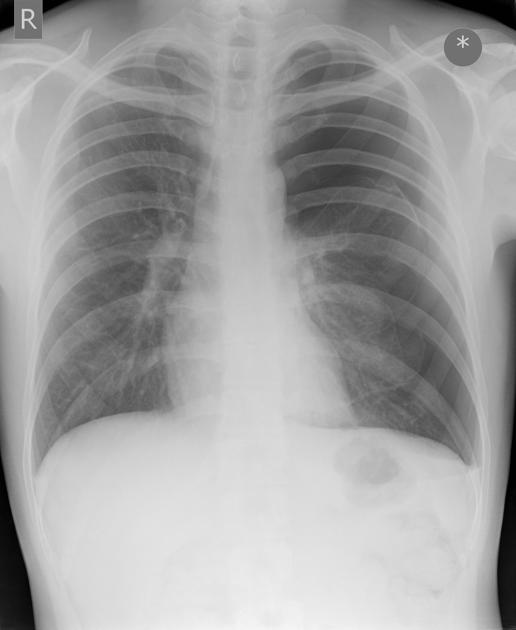WBR0948
| Author | PageAuthor::William J Gibson |
|---|---|
| Exam Type | ExamType::USMLE Step 1 |
| Main Category | MainCategory::Physiology |
| Sub Category | SubCategory::Pulmonology |
| Prompt | [[Prompt::A 19-year-old male presents to the urgent care clinic with the sudden onset of dyspnea and pleuritic chest pain. The patient cannot recall any recent trauma or illness. An upright chest X-ray of the patient is shown below.
Which of the following processes most likely explains this patient’s condition?]] |
| Answer A | AnswerA::Coxsackie B infection |
| Answer A Explanation | AnswerAExp::Incorrect: While Coxsackie B virus infection is the most common cause of pleurisy and pericarditis, the chest x-ray in this patient clearly shows a large left sided pneumothorax. |
| Answer B | AnswerB::Rupture of apical blebs |
| Answer B Explanation | AnswerBExp::Correct: The patient in this vignette most likely has a spontaneous pneumothorax. |
| Answer C | AnswerC::Fat embolism |
| Answer C Explanation | AnswerCExp::Incorrect: While fat embolism can cause dyspnea, it is rare and usually associated with sever physical trauma such as the fracture of long bones. |
| Answer D | AnswerD::Deep vein thrombosis |
| Answer D Explanation | AnswerDExp::Incorrect: The chest x-ray in this patient clearly shows a large left sided pneumothorax. The vignette gives us no other alarming tip-offs for deep vein thrombosis such as prolonged immobility, smoking, or oral contraceptives. |
| Answer E | AnswerE::Fibrillin defect |
| Answer E Explanation | AnswerEExp::Incorrect: While Marfan syndrome can cause pneumothorax, it is far more likely that this patient does not have Marfan syndrome and simply has suffered a spontaneous pneumothorax. |
| Right Answer | RightAnswer::B |
| Explanation | [[Explanation::The patient in this vignette has suffered a spontanoues pneumothorax. Spontaneous pneumothorax tends to occur in tall, thin young males (M:F ratio is 8:1). It is thought to arise due to the rupture of apical “blebs “(small air-filled lesions just under the pleural surface), which are presumed to be more common in those classically at risk of pneumothorax (tall males) due to mechanical factors. In spontaneous pneumothorax, blebs can be found in 77% of cases, compared to 6% in the general population without a history of spontaneous pneuomothorax.
Educational Objective: Spontaneous pneumothorax is due to the rupture of apical “blebs”. References:
First Aid 2013 page 561 |
| Approved | Approved::Yes |
| Keyword | WBRKeyword::Pneumothorax, WBRKeyword::Lung, WBRKeyword::Pleura, WBRKeyword::Dyspnea, WBRKeyword::Chest, WBRKeyword::Chest pain |
| Linked Question | Linked:: |
| Order in Linked Questions | LinkedOrder:: |
